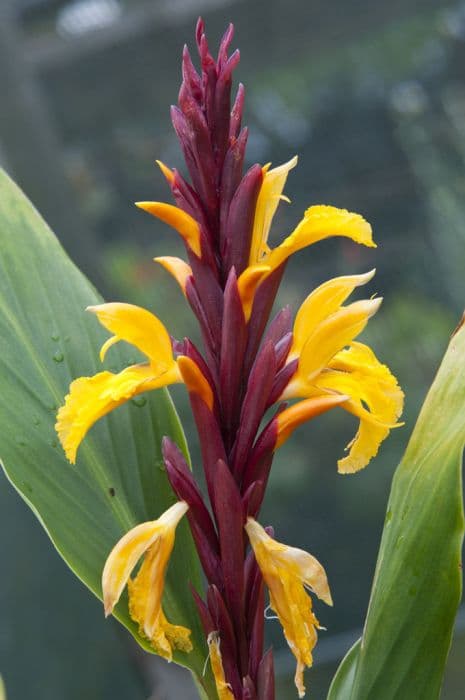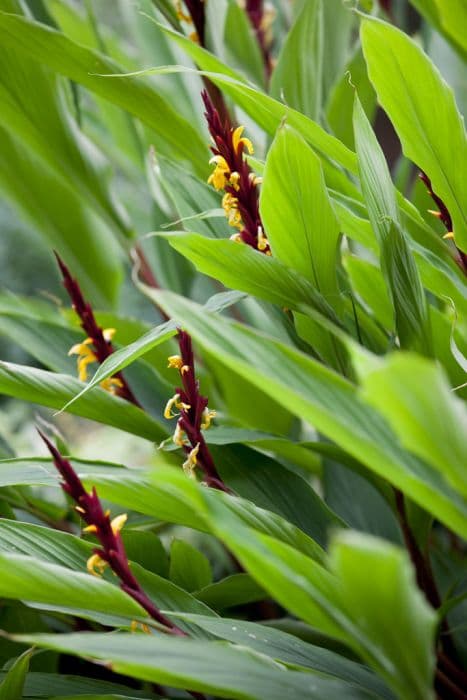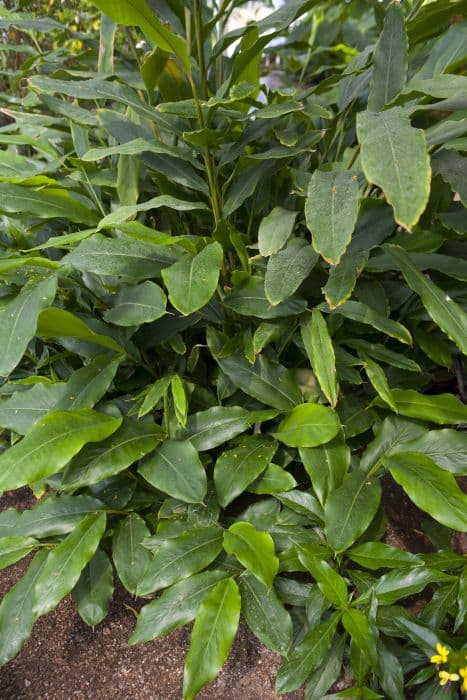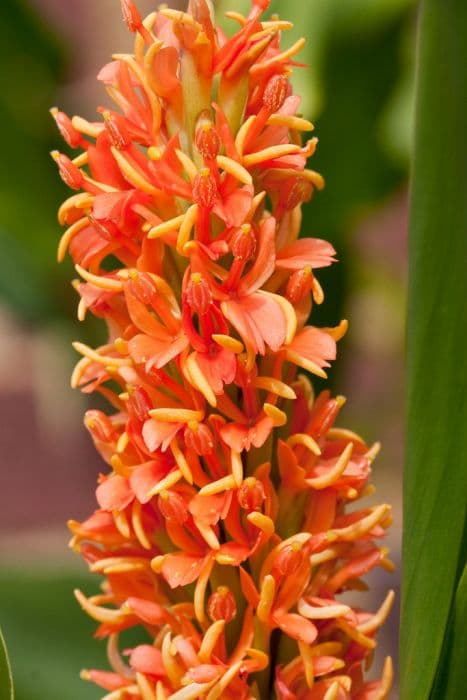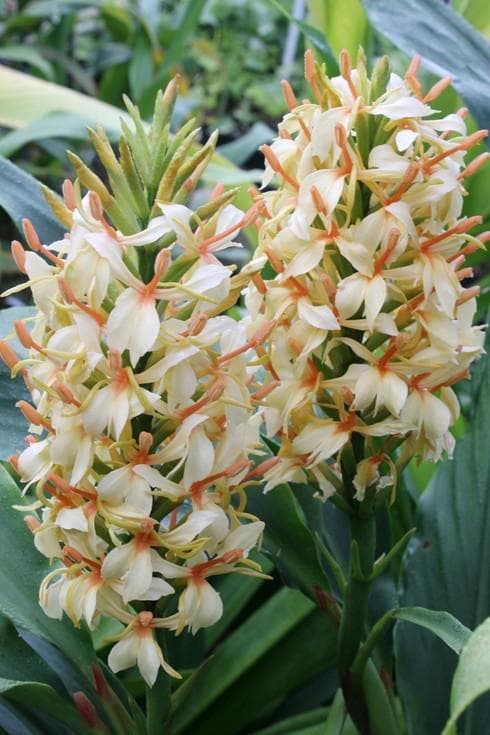Roscoea Beesiana Stripe Group Roscoea × beesiana Gestreept Group

ABOUT
Roscoea × beesiana Gestreept Group, commonly known as Hardy Orchid, is a perennial garden plant that boasts a striking appearance. The plant has slender lance-shaped leaves that emanate a lush green hue, creating a dense clump of foliage at its base. What truly distinguishes this plant are its striking flowers, which blossom resembling those of orchids. These exquisite blooms are often a delightful shade of purple or lavender, sometimes featuring a blend of both with subtle hints or streaks of white to deep violet. The contrast between the delicate flowers and the robust greenery is pronounced, giving the plant a balanced and appealing aesthetic. The flowers are typically funnel-shaped and display a hood-like structure, which gives them an intricate and exotic allure. In full bloom, the Hardy Orchid becomes a focal point in any garden due to its unique and captivating flowers that allure both gardeners and pollinators alike.
About this plant
 Names
NamesSynonyms
Striped Roscoea.
Common names
Roscoea × beesiana Gestreept Group.
 Toxicity
ToxicityTo humans
Roscoea × beesiana, commonly known as Roscoea, does not have a well-documented profile of toxicity to humans. Most members of the genus Roscoea are not known to be toxic, and there is no significant evidence to suggest that Roscoea × beesiana 'Gestreept Group' poses a poisoning risk to humans. Therefore, no specific symptoms of poisoning are associated with this plant. However, it is generally advisable to avoid ingesting plants that are not known to be edible, as they may cause adverse reactions or be potentially toxic.
To pets
Regarding the toxicity of Roscoea × beesiana, commonly referred to as Roscoea, to pets, there is limited information available. Roscoea species are not commonly listed as toxic to pets. This suggests that the likelihood of Roscoea × beesiana 'Gestreept Group' being dangerously toxic to pets is low. Consequently, there are no specific symptoms of poisoning by this plant reported for pets. However, it is always prudent to prevent pets from ingesting plants that are not specifically intended for them, to avoid the risk of gastrointestinal upset or other potential reactions.
 Characteristics
CharacteristicsLife cycle
Perennials
Foliage type
Deciduous
Color of leaves
Green
Flower color
Varies
Height
1 foot 4 inches (40 cm)
Spread
1 foot (30 cm)
Plant type
Herb
Hardiness zones
6
Native area
Asia
Benefits
 General Benefits
General Benefits- Ornamental Value: The plant's striking flowers and foliage add aesthetic appeal to gardens and landscapes.
- Habitat Enrichment: It provides a habitat and food source for pollinators such as bees and butterflies.
- Low Maintenance: Once established, Roscoea × beesiana Gestreept Group is easy to care for, requiring minimal upkeep.
- Drought Tolerance: The plant is capable of surviving periods of low water availability, making it suitable for xeriscaping or drought-prone areas.
- Soil Erosion Control: Its root system can help stabilize soil and prevent erosion in certain settings.
- Seasonal Interest: With seasonal blooms, it offers visual interest at specific times during the growing season.
- Cultural Significance: It may have cultural or historical significance in certain regions, contributing to heritage gardens or conservational efforts.
 Medical Properties
Medical PropertiesThis plant is not used for medical purposes.
 Air-purifying Qualities
Air-purifying QualitiesThis plant is not specifically known for air purifying qualities.
 Other Uses
Other Uses- The Roscoea × beesiana, commonly known as Beesiana Roscoea, can be used in educational settings for plant biology studies, demonstrating the characteristics and growth habit typical of the Zingiberaceae family.
- In culinary arts, although not commonly used, the petals of Beesiana Roscoea may serve as an exotic garnish for specialty dishes, adding a unique aesthetic touch.
- Beesiana Roscoea's rhizomes might be used in the art of natural dyeing, providing a potential source of color for fabrics, given that some related species are known to contain pigments.
- The plant can play a role in ecological education and conservation programs, showcasing biodiversity and the importance of preserving native plant species and their hybrid varieties.
- In creative photography, Beesiana Roscoea provides an attractive subject due to its vivid flowers and unique patterns, which can inspire botanical themed artwork and prints.
- Gardeners may utilize Beesiana Roscoea as a natural pest deterrent, as some garden plants are known to repel insects, although specific research on this hybrid's capabilities may be required.
- For craft enthusiasts, the sturdy leaves of Beesiana Roscoea may be incorporated into creating botanical prints or nature-inspired crafts.
- This plant might find a place in perfumery workshops, where enthusiasts study plant scents and explore the creation of fragrances, assuming the Beesiana Roscoea has a notable aroma as some of its relatives do.
- In horticultural therapy programs, the act of caring for Beesiana Roscoea could offer psychological benefits to participants by fostering a connection with nature and enhancing well-being.
- Beesiana Roscoea could be included in climate adaptation studies, as botanists investigate various plant species' responses to changing climate conditions and potential resilience strategies.
Interesting Facts
 Feng Shui
Feng ShuiRoscoea is not used in Feng Shui practice.
 Zodiac Sign Compitability
Zodiac Sign CompitabilityRoscoea is not used in astrology practice.
 Plant Symbolism
Plant Symbolism- Rarity: Roscoea × beesiana, commonly known as Roscoea, is not a widely known or common garden plant, symbolizing uniqueness and rare beauty.
- Exotic allure: As a hybrid from two different Roscoea species, this plant often represents the allure and mystery of exotic and hybrid identities.
- Adaptability: Roscoeas, in general, are hardy plants that adapt to various environments, symbolizing resilience and the ability to thrive in diverse conditions.
 Water
WaterFor the Hardy Ginger Lily, it's important to maintain consistent moisture during its growing season, typically from spring through early fall. The plant should be watered thoroughly once the top inch of soil feels dry to the touch. This can mean watering once every few days during hot or dry periods, to once a week when temperatures are cooler or there is rainfall. An average recommendation is to provide the Hardly Ginger Lily with about 1 to 1.5 gallons of water per week, depending on the weather and soil drainage. During winter, when the plant is dormant, reduce watering significantly, only ensuring the soil does not completely dry out.
 Light
LightThe Hardy Ginger Lily thrives best in partial shade with some morning sunlight or dappled sunlight throughout the day. It should be protected from the intense afternoon sun, as excessive direct sunlight can scorch the leaves. A spot that receives filtered light or light shade is ideal, ensuring the plant has protection from the strongest rays while still enjoying the benefits of natural light.
 Temperature
TemperatureThe Hardy Ginger Lily can tolerate a range of temperatures but prefers a climate that stays between 60°F and 75°F during the growing season. It is a hardy plant that can survive temperatures as low as 5°F, though it will die back to the ground in freezing conditions and resprout in the spring. This plant favours a moderate climate without extreme heat or prolonged freezing temperatures.
 Pruning
PruningPruning the Hardy Ginger Lily is generally done to remove spent flowers and dead foliage, encouraging a tidy appearance and possibly promoting more blooms. Prune the plant after flowering, typically in late summer or early fall. Cut back any dead stems in spring, before new growth begins. Pruning is not frequently required, but keeping the plant well-groomed can maintain its vigor and aesthetic appeal.
 Cleaning
CleaningAs needed
 Soil
SoilRoscoea purpurea, commonly known as Hardy Ginger, needs well-draining soil with a high organic matter content. A mix containing loam, garden compost, and leaf mold would be ideal. The soil pH for optimal growth should be slightly acidic to neutral, ranging from 6.0 to 7.0.
 Repotting
RepottingHardy Ginger should be repotted every 2-3 years, during spring when signs of growth become evident. It's crucial not to disturb the plant too frequently as it prefers to settle in its environment.
 Humidity & Misting
Humidity & MistingHardy Ginger thrives in moderate to high humidity levels. Ensuring a humidity of around 60% is typically beneficial for the plant's health without requiring special humidity adjustments in most temperate climates.
 Suitable locations
Suitable locationsIndoor
Provide bright, indirect light and keep soil moist.
Outdoor
Plant in dappled shade, protect from strong winds and heavy frost.
Hardiness zone
6-9 USDA
 Life cycle
Life cycleThe plant in focus, known commonly as Roscoea, begins its life cycle when a seed germinates, typically in early spring, to produce a small seedling. The seedling grows into a juvenile plant, developing a characteristic tuberous root system that aids in its survival through seasonal changes. As the plant matures, it forms basal leaves and elongates to produce flowering stems, typically in late spring or early summer. The flowers of Roscoea are pollinated by insects, leading to the formation of seed capsules that contain the seeds for the next generation. After flowering, the plant begins to die back, with the aerial parts withering away, while the tuberous roots remain dormant underground during the colder months. The following spring, the plant re-emerges from the tuber, thus perpetuating its life cycle.
 Propogation
PropogationPropogation time
Spring to summer
For the Roscoea × beesiana Gestreept Group, commonly known as Hardy Ginger or Roscoea, division is the most popular method of propagation. This is typically undertaken in the spring just as the plants begin to emerge from dormancy. Gardeners should carefully lift the clump of Roscoea from the ground using a shovel or fork, ensuring minimal damage to the rhizomes. The clump should then be gently separated into smaller sections, each with at least one growing point or 'eye'. These sections can be immediately replanted in well-draining soil at a depth of about 2 inches (or around 5 centimeters), spaced approximately 12 inches (30 centimeters) apart to allow for future growth. Providing the divisions with consistent moisture and avoiding deep watering will help establish the plants in their new location.
